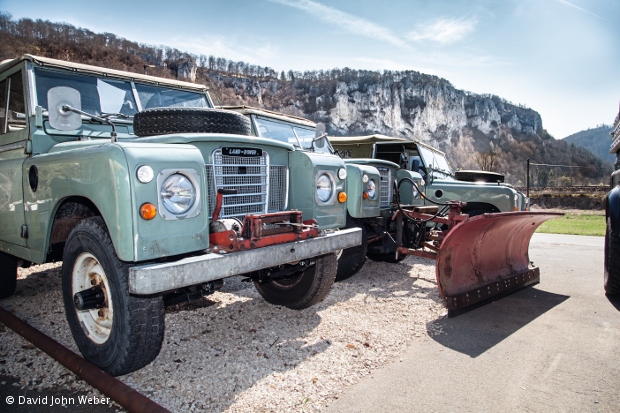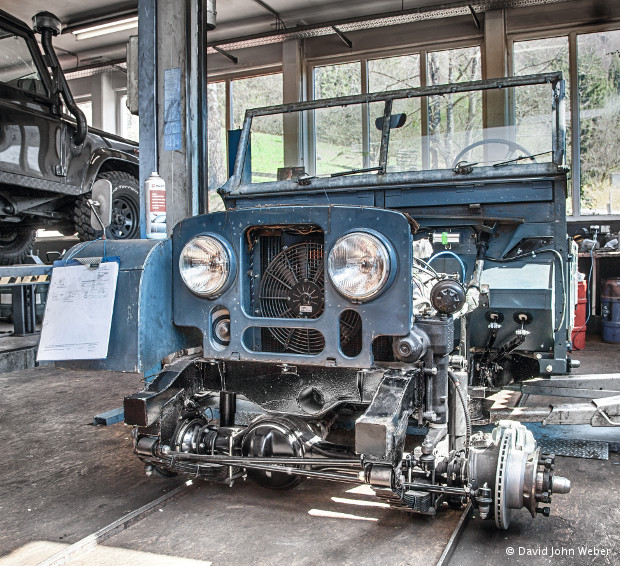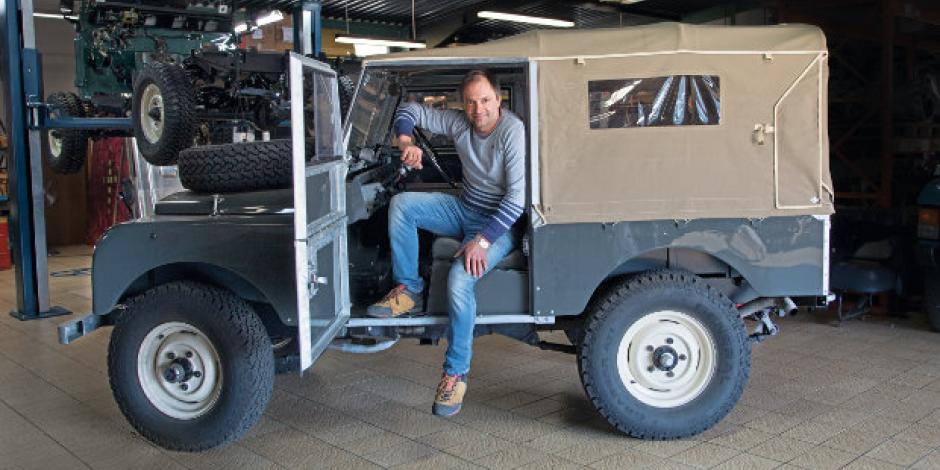Some to adoreverehrenadore the rusticrustikal, urigrustic charm. Others love how they conquer even the toughest terrain. No wonder classic Land Rovers have such immense cult appeal.
The Rover Company started making them at its Solihull plant near Birmingham, England, in 1948. That same year, King George VI was presented with the 100th production Land Rover. His daughter, later Queen Elizabeth II, loves Landys, too. A passion for these cars comes with the territory in the United Kingdom. But how on earth did they become a hit here in Deutschland?
Mehr über britisches Leben in Deutschland erfahren Sie auch im Magazin von Babbel, unserem Kooperationspartner für dieses Thema.
Road trip
I take this question for a drive in my Land Rover, a green Defender with a white top. First, I to motor(mit dem Auto) fahrenmotor through Kempten, a Bavarian city with Roman roots. Then I cross into Baden-Württemberg, where castles top every other hill. Driving this type of Land Rover means going along at about 100 kph, max. It’ll be hours until I reach Naturpark Obere Donau.
I see three other Land Rovers on the narrow country roads. Each driver gives me a wave and a smile. Like my Defender, their vehicles belong to Land Rover’s utility range. The prototype was first built on the chassis of a Willys US Army jeep in 1947. Its signaturehier: unverkennbarsignature boxy bodyeckige Karosserieboxy body was formed with aluminium left over from the manufacture of British warplanes.
Developed for farm work by Rover engineer Maurice Wilks, the no-frillsschlicht, schmucklosno-frills light-weight jeep soon became a leisure vehicle, too — for horse people, hikers and safari operators. The oldest Land Rovers, Series I, II and III, were made from 1948 to 1985. Then came the Ninety and the One Ten, produced as of the early 1980s. The Defender, which remains a familiar sight on European roads, was launched in 1990. In 2015, though, production of the utility range came to an end. People said the vehicles were out of step with the times.
I to shifthier: schaltenshift into fourth gearGanggear, and the enormous form of Sigmaringen Castle comes into view. After a few kilometres, white cliffs rise up beside the road. Now I’m in the heart of the Upper Danube Nature Park. Motorcycles race by, to hughier: sich hineinlegenhugging the curves of the L277. In one of these bends is Landypoint, a famous restoration specialist for Land Rover vehicles.
Meet and greet
A man in his late forties with brown hair and sparklingfunkelndsparkling eyes meets me at reception. Urs Stiegler started the business in 1999 by turning a hobby — restoring and selling old Land Rovers — into a commercially viablemachbar, durchführbarviable idea. Over time, his business model changed: instead of buying cars from him, Landy drivers began taking cars to him. Some wanted extensive restoration work, even total rebuilds.
Stiegler says his shop now handles three to four big projects concurrentlygleichzeitigconcurrently, jobs that start at €50,000, but can cost three to four times that. Getting the right parts is keyhier: entscheidendkey: Landypoint to source sth.etw. beziehensources nearly all of them from well-known UK companies like Britpart and Bearmach.
“In Germany, you have maybe ten shops that sell the parts, but they have no garage,” Stiegler points out. “As we have both, we can say relatively quickly if a part is working OK, or if it has a quality problem because we use it in our own workshop.”
I look at the Series I Land Rovers parked in the reception area. They’re so stately, so British. Queen Elizabeth once toured parts of the Commonwealth in exactly this type of vehicle. As I admire the cars, a Labrador retriever to collide with sth.mit etw. zusammenstoßen; hier: etw. anstupsencollides with my knee. The brown dog waits for a patTätscheln, Streichelnpat on the head, then wanders off towards a sunny spot by a window. Just outside are classic Landys — more than I can count.
Land Rovers have been seen around Germany for the past 30 years or so, but before that, there was no garage for them — nothing
“Ever since I was a child, my family visited Switzerland, especially Graubünden,” Stiegler says. “You would see a lot of Land Rovers there, mostly Series IIs and IIIs. They were everywhere. There weren’t a lot of other 4x4 cars out there at the time, and the Swiss needed them for the mountains.”
The Swiss developed a thinghier: Begeisterung, Schwächething for British cars early on. One reason, Stiegler to reckonmeinen, glaubenreckons, is that they had no car factories of their own. It was a mechanic named Emil Frey who got the ball rolling. Stiegler describes how, in the 1940s, Frey started to bring the first Rover cars over to mainland Europe. He built up a business selling automobiles and doing the spare-parts distributionErsatzteilvertriebspare-parts distribution. Frey is still a big name: Automotive News Europe ranks the car dealer as Europe’s third largest. As a result of Frey’s work, Switzerland became a hubKnotenpunkthub for all things Land Rover.
“Land Rovers have been seen around Germany for the past 30 years or so, but before that, there was no garage for them — nothing,” Stiegler says.

Show and tell
From reception, we walk into a hall that was once the showroom. Now it houses some of Landypoint’s big projects.
“This is a car that we are restoring to the highest standards for a Swiss client,” he says, pointing to a vehicle chassis. “This is all new,” he says, referring to a set of bareblankbare metal panelMetallplattemetal panels that will soon form the body of the car
“The thing is, you can do a nearly similar restoration job for €50,000 for a car that ‘just drives’. But the jobs we do are in the area of €150,000 because every little part is specially made. The question is not how it can be made cheaper, but how it can it be made better. Every part you can galvanize is galvanized.”
Das Spotlight Sprachmagazin
Die Welt spricht Englisch: Sprechen Sie mit! Mit dem Spotlight Magazin verbessern Sie Ihren englischen Wortschatz kontinuierlich und erfahren zudem Wissenswertes aus der englischsprachigen Welt. Jetzt mehr erfahren!
We walk on. Stiegler stops in front of a perfectly restored 1950s’ Land Rover.
“Look at this Series I,” he says. “It has a 3.9-litre V8 engine, vented disc brakesinnenbelüftete Scheibenbremsenvented disc brakes and power steeringServolenkungpower steering from a P38 Range Rover.”
The workings of a luxury Land Rover SUV from the 1990s have been built into a vintage vehicle from the no-frills utility range. It’s the best of both worlds, especially given that an old Land Rover drives, in Stiegler’s words, “like a tractor”. I ask him what it cost to restore. “This car was €180,000,” he says.
He opens the bonnetMotorhaubebonnet. The engine area still looks original, which is quite a featMeisterstückfeat. Stiegler climbs in to the driver’s seat and starts the car. “It drives like a Morgan — really,” he says. “It’s a sports car.”
He to revaufheulen lassenrevs the motor to a throatyrau, heiserthroaty roarDröhnenroar. Seeing Stiegler there at the wheel, it occurs to me that I may never have seen a grown man look so happy.
He cuts the engine and motions me over, pointing to the driver’s door. When such Land Rovers came from the factory, they typically had gaps between the body of the car and the door. That’s just how they were manufactured. For this workshop, it is one of many areas where improvements can be made on the original.

At Landypoint, they do so by taking the car apart, to strip from sth.von etw. abziehen; hier: von etw. entfernenstripping the rust and paint from the body, then sending parts of it to the coachbuilderKarosseriebauercoachbuilder for changes if necessary. When the body is back at Landypoint, the team builds the car together again, until it is fully drivable. That way they can see if they’ve missed anything: a hole for a wire, a bit that needs to be to weldschweißenwelded on.
After the car has been checked and the adjustmentEinstellung, Anpassungadjustments made, they to dismantlezerlegen, auseinandernehmendismantle it again, leaving only the chassis in place. “Then all single parts are painted,” Stiegler says. He points at the car door. “When we rebuilt this car the first time, we cut all the frames here,” he says, meaning the door, “and welded them while in the car. That’s why the gaps are so perfect.”
Sure enough, it’s a lovely, tight fit — not at all like my 1999 Defender. Sitting in that on the passenger side during a heavy rain, your feet get wet. The owner of this car will have dry shoes. What’s more, the driving experience will be superior.
About 70 per cent of Stiegler’s clients are German, the rest Swiss. What about the Brits? Stiegler tells me about Philip Bashall, the man behind the Dunsfold Collection, the world’s largest assemblageSammlungassemblage of model Land Rovers, with more than 2,000 vehicles. His father, Brian Bashall, started collecting them in the 1950s. Phil Bashall has a restoration company, too, and is one of the top names when it comes to authenticity in Land Rovers. “And he says to my British friend, ‘If I had the money to build up a Range Rover just for me, I would take it to Landypoint.’”
Landypoint
Neidinger Str. 41
88631 Beuron-Neidingen
www.landy-point.de




